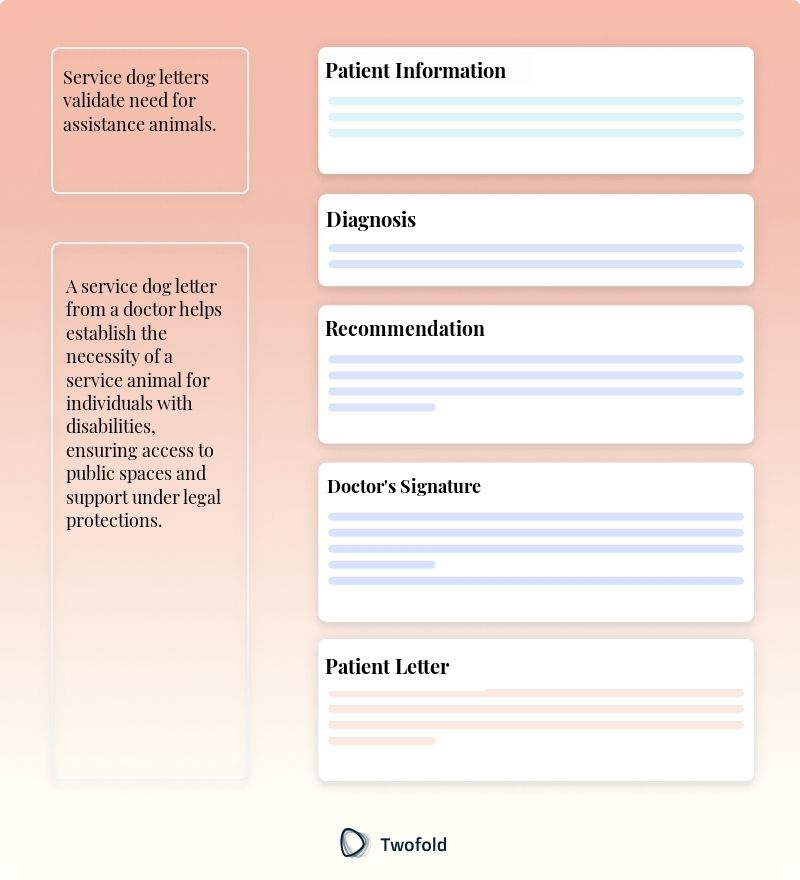
Service Dog Letter From Doctor Template
Many people find themselves in need of a service dog letter from a doctor, whether due to anxieties, PTSD, or a myriad of other health concerns. Navigating the process can feel overwhelming, especially if you’re unsure of the right steps to take. Don’t worry; this guide will help you understand what you need to create a compelling letter that clearly indicates your need for a service dog.
What Is a Service Dog Letter From Doctor Template?
A service dog letter from a doctor is a formal document that confirms a patient's need for a service animal. This letter serves to validate the health condition and the necessity of the trained dog to assist in daily tasks.
Using a template can simplify the process, ensuring that all vital information is included in a structured manner. This approach can help both the patient and healthcare provider in drafting an effective letter quickly.
Key Components of a Service Dog Letter Template
The following points are critical when crafting a service dog letter:
- Patient’s full name and contact information
- Provider's credentials and contact information
- Date of the letter
- Statement of the patient's condition
- Explanation of how the service dog assists the patient
- Provider’s signature

How to Use a Service Dog Letter From Doctor Template: Step-by-Step Process
- Obtain or download a service dog letter template.
- Fill in the patient's personal information at the top of the letter.
- Provide detailed information about the patient’s condition.
- Describe the specific tasks the service dog will perform.
- Sign the letter with professional credentials and date it.
- Provide a copy to the patient for their records.
Benefits of a Service Dog Letter
Benefit | Description |
|---|---|
Legal Protection | Helps ensure compliance with the Americans with Disabilities Act. |
Access to Public Places | Allows entry with the service dog into restaurants, stores, and transportation. |
Awareness and Understanding | Educates others about the necessity of service dogs for certain conditions. |
Support in Housing | Facilitates support for tenant rights in no-pet policies under Fair Housing laws. |
Emotional Well-Being | Provides validation of the patient’s needs, contributing to mental health improvement. |
Stakeholders in Service Dog Letter Template
Several stakeholders are involved in the process of acquiring a service dog letter. Each plays a crucial role in ensuring that patients receive proper support.
- Healthcare Providers: They issue the letter, ensuring it contains accurate information about the patient's condition.
- Patients: They require the letter to access legal protections and public accommodations.
- Service Dog Trainers: They train the dogs to perform specific tasks that assist the patient effectively.
- Legal Advisors: They provide guidance to ensure compliance with disability laws.
Example of a Service Dog Letter From Doctor
Here’s an example of how a service dog letter might look:
Real-World Use Cases: Practical Impact of the Service Dog Letter Template
Understanding the real‑world implications of the service dog letter can highlight its importance:
- Veterans: a veteran with PTSD secures a service dog letter, helping him to go to social events without anxiety, improving his quality of life.
- Children: a child with autism receives a letter granting access to a service dog that calms him during crowded school events, reducing stress for both the child and parents.
- Fear of Flying: An individual with severe anxiety uses the letter to travel by air, resulting in a more comfortable journey thanks to the support of a service dog.
Conclusion
A service dog letter from a doctor is a vital tool for individuals needing assistance from a trained animal. Understanding its components, importance, and proper format can empower patients in their quest for support. This guide provides practical steps and expert tips that streamline the process and enhance compliance with legal standards.
Disclaimer: This article is for informational purposes only and does not constitute legal or medical advice. Always consult professional guidelines and regulatory bodies for specific compliance requirements.

Dr. Danni Steimberg
Dr. Danni Steimberg is a pediatrician at Schneider Children’s Medical Center with extensive experience in patient care, medical education, and healthcare innovation. He earned his MD from Semmelweis University and has worked at Kaplan Medical Center and Sheba Medical Center.
Drafting a Service Dog Letter From Doctor goes beyond a simple statement—it solidifies the patient’s need for a service animal, confirming medical legitimacy and ensuring legal protections. By detailing the patient’s specific condition and how a service dog mitigates it, you craft a document that truly supports the patient’s daily life and mental health.
- Emphasize Medical Necessity: Clearly link the patient’s diagnosis to the functional benefits a service dog provides. Whether it’s interrupting anxiety episodes or aiding mobility, this connection assures landlords, employers, or other entities that the dog isn’t just a pet—it’s part of a prescribed treatment plan.
- Specify Tasks and Roles: Outline the precise tasks the dog performs, such as retrieving medication or guiding during disorientation. This helps differentiate a service dog from an emotional support animal and strengthens compliance with regulations like the ADA.
- Reinforce Ongoing Care: Note that the service dog recommendation is part of a broader, continuous treatment plan. Mention follow-ups or additional services (e.g., therapy, medication monitoring) to show that the patient’s healthcare is monitored, structured, and necessary for lasting well-being.
Frequently Asked Questions
Reduce burnout,
improve patient care.
Join thousands of clinicians already using AI to become more efficient.

Case Conceptualization Template
Discover practical Case Conceptualization templates to enhance your documentation efficiency.

Social Work Treatment Plan Template
Discover practical Social Work Treatment Plan templates to enhance your documentation efficiency.

Biopsychosocial Assessment Template
Discover practical Biopsychosocial Assessment Template to enhance your documentation efficiency.


